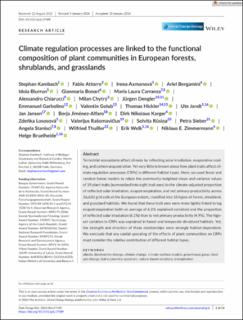Please use this identifier to cite or link to this item:
https://doi.org/10.21256/zhaw-30464| Publication type: | Article in scientific journal |
| Type of review: | Peer review (publication) |
| Title: | Climate regulation processes are linked to the functional composition of plant communities in European forests, shrublands, and grasslands |
| Authors: | Kambach, Stephan Attorre, Fabio Axmanová, Irena Bergamini, Ariel Biurrun, Idoia Bonari, Gianmaria Carranza, Maria Laura Chiarucci, Alessandro Chytrý, Milan Dengler, Jürgen Garbolino, Emmanuel Golub, Valentin Hickler, Thomas Jandt, Ute Jansen, Jan Jiménez-Alfaro, Borja Karger, Dirk Nikolaus Lososová, Zdeňka Rašomavičius, Valerijus Rūsiņa, Solvita Sieber, Petra Stanisci, Angela Thuiller, Wilfried Welk, Erik Zimmermann, Niklaus E. Bruelheide, Helge |
| et. al: | No |
| DOI: | 10.1111/gcb.17189 10.21256/zhaw-30464 |
| Published in: | Global Change Biology |
| Volume(Issue): | 30 |
| Issue: | 2 |
| Page(s): | e17189 |
| Issue Date: | Feb-2024 |
| Publisher / Ed. Institution: | Wiley |
| ISSN: | 1365-2486 |
| Language: | English |
| Subjects: | Albedo; Biodiversity change; Climate change; Climate-surface models; Greenhouse gases; Land use change; Leaf economics spectrum; Nature-based solution; Transpiration; Plants; Climate; Climatic processes; Biodiversity; Ecosystem; Grassland |
| Subject (DDC): | 333.7: Land, natural recreational areas 577: Ecology |
| Abstract: | Terrestrial ecosystems affect climate by reflecting solar irradiation, evaporative cooling, and carbon sequestration. Yet very little is known about how plant traits affect climate regulation processes (CRPs) in different habitat types. Here, we used linear and random forest models to relate the community-weighted mean and variance values of 19 plant traits (summarized into eight trait axes) to the climate-adjusted proportion of reflected solar irradiation, evapotranspiration, and net primary productivity across 36,630 grid cells at the European extent, classified into 10 types of forest, shrubland, and grassland habitats. We found that these trait axes were more tightly linked to log evapotranspiration (with an average of 6.2% explained variation) and the proportion of reflected solar irradiation (6.1%) than to net primary productivity (4.9%). The highest variation in CRPs was explained in forest and temperate shrubland habitats. Yet, the strength and direction of these relationships were strongly habitat-dependent. We conclude that any spatial upscaling of the effects of plant communities on CRPs must consider the relative contribution of different habitat types. |
| URI: | https://digitalcollection.zhaw.ch/handle/11475/30464 |
| Fulltext version: | Published version |
| License (according to publishing contract): | CC BY-NC 4.0: Attribution - Non commercial 4.0 International |
| Departement: | Life Sciences and Facility Management |
| Organisational Unit: | Institute of Natural Resource Sciences (IUNR) |
| Appears in collections: | Publikationen Life Sciences und Facility Management |
Files in This Item:
| File | Description | Size | Format | |
|---|---|---|---|---|
| 2024_Kambach-etal_ Climate-regulation-processes-functional-composition-plant_gcb.pdf | 2.36 MB | Adobe PDF |  View/Open |
Show full item record
Kambach, S., Attorre, F., Axmanová, I., Bergamini, A., Biurrun, I., Bonari, G., Carranza, M. L., Chiarucci, A., Chytrý, M., Dengler, J., Garbolino, E., Golub, V., Hickler, T., Jandt, U., Jansen, J., Jiménez-Alfaro, B., Karger, D. N., Lososová, Z., Rašomavičius, V., et al. (2024). Climate regulation processes are linked to the functional composition of plant communities in European forests, shrublands, and grasslands. Global Change Biology, 30(2), e17189. https://doi.org/10.1111/gcb.17189
Kambach, S. et al. (2024) ‘Climate regulation processes are linked to the functional composition of plant communities in European forests, shrublands, and grasslands’, Global Change Biology, 30(2), p. e17189. Available at: https://doi.org/10.1111/gcb.17189.
S. Kambach et al., “Climate regulation processes are linked to the functional composition of plant communities in European forests, shrublands, and grasslands,” Global Change Biology, vol. 30, no. 2, p. e17189, Feb. 2024, doi: 10.1111/gcb.17189.
KAMBACH, Stephan, Fabio ATTORRE, Irena AXMANOVÁ, Ariel BERGAMINI, Idoia BIURRUN, Gianmaria BONARI, Maria Laura CARRANZA, Alessandro CHIARUCCI, Milan CHYTRÝ, Jürgen DENGLER, Emmanuel GARBOLINO, Valentin GOLUB, Thomas HICKLER, Ute JANDT, Jan JANSEN, Borja JIMÉNEZ-ALFARO, Dirk Nikolaus KARGER, Zdeňka LOSOSOVÁ, Valerijus RAŠOMAVIČIUS, Solvita RŪSIŅA, Petra SIEBER, Angela STANISCI, Wilfried THUILLER, Erik WELK, Niklaus E. ZIMMERMANN und Helge BRUELHEIDE, 2024. Climate regulation processes are linked to the functional composition of plant communities in European forests, shrublands, and grasslands. Global Change Biology. Februar 2024. Bd. 30, Nr. 2, S. e17189. DOI 10.1111/gcb.17189
Kambach, Stephan, Fabio Attorre, Irena Axmanová, Ariel Bergamini, Idoia Biurrun, Gianmaria Bonari, Maria Laura Carranza, et al. 2024. “Climate Regulation Processes Are Linked to the Functional Composition of Plant Communities in European Forests, Shrublands, and Grasslands.” Global Change Biology 30 (2): e17189. https://doi.org/10.1111/gcb.17189.
Kambach, Stephan, et al. “Climate Regulation Processes Are Linked to the Functional Composition of Plant Communities in European Forests, Shrublands, and Grasslands.” Global Change Biology, vol. 30, no. 2, Feb. 2024, p. e17189, https://doi.org/10.1111/gcb.17189.
Items in DSpace are protected by copyright, with all rights reserved, unless otherwise indicated.